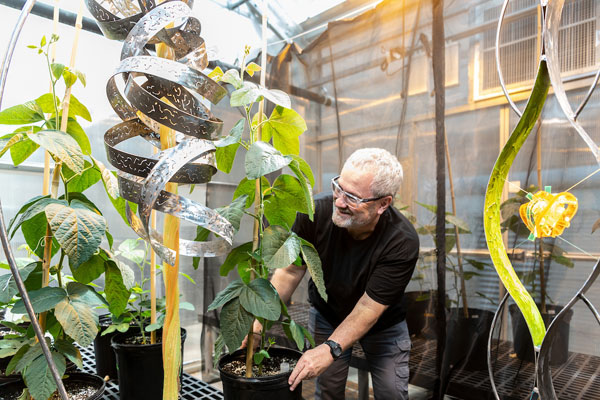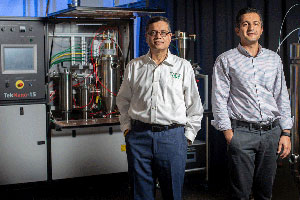|
|
|
|
|
|
 | S
|
Creating Sculptures Inspired by UNT Plant Research
Lately, Phil Samson has been pouring over scientific research papers from scholars in UNT's College of Science. Though the studio art graduate student in the College of Visual Arts and Design has no background in science, he's found the research to be quite an artistic muse. His own attempts at planting a pandemic garden in his backyard last year and experience helping relatives during the summer on their family farms in Nebraska fueled his interest in plant science and questioning about the purpose of gene modification. At the encouraging of faculty members on his M.F.A. thesis committee, Samson reached out to UNT botanists like Kent Chapman and Richard Dixon in the BioDiscovery Institute to understand current research in the field. Some of his pieces, where arts meets science, have found a home in the institute where they have added much more than aesthetics.
|
|
|
|
|
|
|
|
 Developing a New Alloy for NASA Developing a New Alloy for NASA
Materials science and engineering researchers Rajiv Mishra (left) and Aidin Imandoust (right) are creating a new alloy for protective linings in nuclear fusion reactors and other nuclear applications through a NASA Cooperative Agreement Notice that provides funding and research support from NASA scientists. The tungsten-based alloy will be specifically designed for laser-based additive manufacturing to withstand high temperatures when shielding the reactor from the plasma created during fusion. The facilities at UNT's Center for Agile and Adaptive Additive Manufacturing and UNT's Materials Research Facility will enable the development of their research.
|
|
|
|
|
|
| Researching at Rock & Roll Hall of Fame |
Using his expertise as a musicologist and popular music scholar, Brian F. Wright, assistant professor of music history, is revealing the history of American popular music looks much different when viewed through the lens of the electric bass. As a recipient of the Society for American Music's Charles Hamm Fellowship, Wright explored the Rock and Roll Hall of Fame's Library and Archives as part of a two-week research residency. He traveled to the archives in August, where he sifted through primary sources, such as behind-the-scenes business files, contemporary music magazines and newspapers, personal papers and more to detail the history of the electric bass — overlooked by academia until now.
|
|
|
|
|
|
|
| Addressing Mental Health Disparities |
|
Four UNT researchers are addressing health disparities by training the next generation of counselors and social workers to offer trauma-informed, bilingual mental health services to minorities in both behavioral health and integrated care settings. (Left to right) Angie Cartwright, associate professor; Peggy Ceballos, associate professor; and Chandra Carey, associate dean from the College of Education and Dhru Mukherjee, associate professor, from the College of Health and Public Service are collaborating on the project funded through a $1.5 million grant from the U.S. Health Resources and Services Administration. The project addresses the need for care for underserved populations and incorporates trauma-informed mental healthcare into integrated care with a bilingual component.
|
|
|
|
|
|
|
| Revolutionizing Ammonia Production |
|
In creating a more environmentally friendly way to produce ammonia — a chemical vital to agriculture worldwide — not only could greenhouse gases be lowered, but there could be big cost saving benefits. Chemistry professors Thomas Cundari, Francis D'Souza and Jeffry Kelber received a $500,000 National Science Foundation grant to investigate fundamental chemical interactions for nitrogen reduction reactions needed to produce ammonia through electrocatalysis. They hope their work eventually could lead to prototypes that produce ammonia using only sunlight, water and nitrogen from air, creating economic benefits for farmers and reducing the cost of foods.
|
|
|
|
|
|
|
| Tackling Worldwide Heart Issue |
|
Hamid Sadat, assistant professor of mechanical engineering, recently received a National Institutes of Health grant to examine calcific aortic valve disease (CAV) — the most common valve disease in elderly people, found in nearly 2.6 million people worldwide. The funding will allow Sadat, alongside medical professionals at Baylor University Medical Center, to tackle the disease through three phases, the first of which focuses on developing a computational model to understand how CAV occurs and how it can be diagnosed. The team will use a unique computational code developed at UNT to model fluid dynamics and mimic the flow of blood through a heart.
|
|
|
|
|
|
|
| Collaborating for Advanced Medical Security |
|
Bibhudutta Rout, associate professor of physics; Saraju Mohanty, professor of computer science and engineering; and Elias Kougianos, professor of electrical engineering, are collaborating with a team led at Grambling State University on a new National Science Foundation grant to advance security in implantable and wearable medical devices. Devices such as insulin pumps can be hacked quite easily, or in the case of some pacemakers, connect to Wi-Fi but have no security features. The unique interdisciplinary team is working on much needed cybersecurity for the Internet-of-Medical-Things.
|
|
|
|
|
|